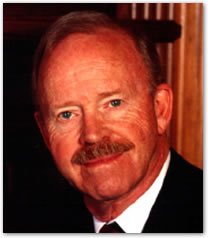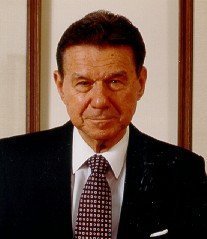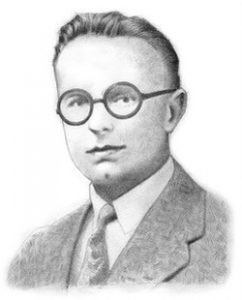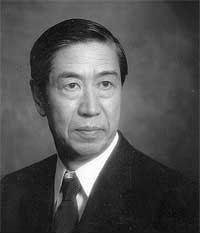Concerns for quality and process control is nothing new. Historians have traced the concept as far back as 3000 B.C. Process control is a concept that may have begun with pyramids of Egypt when a system for quarrying and dressing stone was designed. One has only to examine the pyramids at Cheops to appreciate this remarkable achievement.
Over the past few decades, there have been several leaders who have been instrumental in developing the concept of quality as understood today.
DR. W. EDWARDS DEMING
 Dr. W. Edward Deming is best known for reminding management that most problems are systemic and that it is management’s responsibility to improve the systems so that workers (management and non-management) can do their jobs more effectively.
Dr. W. Edward Deming is best known for reminding management that most problems are systemic and that it is management’s responsibility to improve the systems so that workers (management and non-management) can do their jobs more effectively.
Deming argued that higher quality leads to higher productivity, which, in turn, leads to long-term competitive strength. The theory is that improvements in quality lead to lower costs and higher productivity because they result in less rework, fewer mistakes, fewer delays, and better use of time and materials. With better quality and lower prices, a firm can achieve a greater market share and thus stay in business, providing more and more jobs.
When he died in December 1993 at the age of ninety-three, Deming had taught quality and productivity improvement for more than fifty years. His Fourteen Points, System of Profound Knowledge, and teachings on statistical control and process variability are studied by people all over the world. His books include: Out of the Crisis (1986), The New Economics (1993), and Statistical Adjustment of Data (1943).
In emphasizing management’s responsibility, Deming noted that workers are responsible for 10 to 20 percent of the quality problems in a factory and that the remaining 80 to 90 percent is under management’s control. Workers are responsible for communicating to management the information they possess regarding the system. Deming’s approach requires an organization-wide cultural transformation.
Deming’s philosophy is summarized in his famous fourteen points, and it serves as a framework for quality and productivity improvement. Instead of relying on inspection at the end of the process to find flaws, Deming advocated a statistical analysis of the manufacturing process and emphasized cooperation of workers and management to achieve high-quality products.
Deming’s quality methods centered on systematically tallying product defects, analyzing their causes, correcting the causes, and recording the effects of the corrections on subsequent product quality as defects were prevented. He taught that it is less costly in the long run to get things done right the first time then fix them later.
DR. JOSEPH JURAN
 Dr. Juran was born on December 24, 1904, in Braila, Romania. He moved to the United States in 1912 at the age of 8. Juran’s teaching and consulting career spanned more than seventy years, known as one of the foremost experts on quality in the world.
Dr. Juran was born on December 24, 1904, in Braila, Romania. He moved to the United States in 1912 at the age of 8. Juran’s teaching and consulting career spanned more than seventy years, known as one of the foremost experts on quality in the world.
A quality professional from the beginning of his career, Juran joined the inspection branch of the Hawthorne Co. of Western Electric (a Bell manufacturing company) in 1924, after completing his B.S. in Electrical Engineering. In 1934, he became a quality manager. He worked with the U. S. government during World War II and afterward became a quality consultant. In 1952, Dr. Juran was invited to Japan. Dr. Edward Deming helped arrange the meeting that led to this invitation and his many years of work with Japanese companies.
Juran founded the Juran Center for Quality Improvement at the University of Minnesota and the Juran Institute. His third book, Juran’s Quality Control Handbook, published in 1951, was translated into Japanese. Other books include Juran on Planning for Quality (1988), Juran on Leadership for Quality (1989), Juran on Quality by Design (1992), Quality Planning and Analysis(1993), and A History of Managing for Quality (1995). Architect of Quality (2004) is his autobiography.
PHILIP CROSBY
 Philip Bayard Crosby was born in Wheeling, West Virginia, in 1926. After Crosby graduated from high school, he joined the Navy and became a hospital corpsman. In 1946 Crosby entered the Ohio College of Podiatric Medicine in Cleveland. After graduation, he returned to Wheeling and practiced podiatry with his father. He was recalled to military service during the Korean conflict, this time he served as a Marine Medical Corpsman.
Philip Bayard Crosby was born in Wheeling, West Virginia, in 1926. After Crosby graduated from high school, he joined the Navy and became a hospital corpsman. In 1946 Crosby entered the Ohio College of Podiatric Medicine in Cleveland. After graduation, he returned to Wheeling and practiced podiatry with his father. He was recalled to military service during the Korean conflict, this time he served as a Marine Medical Corpsman.
In 1952 Crosby went to work for the Crosley Corp. in Richmond, Indiana, as a junior electronic test technician. He joined the American Society for Quality, where his early concepts concerning Quality began to form. In 1955, he went to work for Bendix Corp. as a reliability technician and quality engineer. He investigated defects found by the test people and inspectors.
In 1957 he became a senior quality engineer with Martin Marietta Co. in Orlando, Florida. During his eight years with Martin Marietta, Crosby developed his “Zero Defects” concepts, began writing articles for various journals, and started his speaking career.
In 1965 International Telephone and Telegraph (ITT) hired Crosby as vice president in charge of corporate quality. During his fourteen years with ITT, Crosby worked with many of the world’s largest industrial and service companies, implementing his pragmatic management philosophy, and found that it worked.
After a number of years in industry, Crosby established the Crosby Quality College in Winter Park, Florida. He is well known as an author and consultant and has written many articles and books. He is probably best known for his book Quality is Free (1979) and concepts such as his Absolutes of Quality Management, Zero Defects, Quality Management Maturity Grid, 14 Quality Improvement Steps, Cost of Quality, and Cost of Nonconformance.
Attention to customer requirements and preventing defects is evident in Crosby’s definitions of quality and “non-quality” as follows: “Quality is conformance to requirements; non-quality is nonconformance.”
ARMAND V. FEIGENBAUM
 Feigenbaum was still a doctoral student at the Massachusetts Institute of Technology when he completed the first edition of Total Quality Control (1951). An engineer at General Electric during World War II, Feigenbaum used statistical techniques to determine what was wrong with early jet airplane engines. For ten years he served as manager of worldwide manufacturing operations and quality control at GE. Feigenbaum serves as president of General Systems Company, Inc., Pittsfield, Massachusetts, an international engineering firm that designs and installs integrated operational systems for major corporations in the United States and abroad.
Feigenbaum was still a doctoral student at the Massachusetts Institute of Technology when he completed the first edition of Total Quality Control (1951). An engineer at General Electric during World War II, Feigenbaum used statistical techniques to determine what was wrong with early jet airplane engines. For ten years he served as manager of worldwide manufacturing operations and quality control at GE. Feigenbaum serves as president of General Systems Company, Inc., Pittsfield, Massachusetts, an international engineering firm that designs and installs integrated operational systems for major corporations in the United States and abroad.
Feigenbaum was the founding chairman of the International Academy for Quality and is a past president of the American Society for Quality Control, which presented him its Edwards Medal and Lancaster Award for his contributions to quality and productivity. His Total Quality Control concepts have had a very positive impact on quality and productivity for many organizations throughout the industrialized world.
DR. H. JAMES HARRINGTON
 An author and consultant in the area of process improvement, Harrington spent forty years with IBM. His career included serving as Senior Engineer and Project Manager of Quality Assurance for IBM, San Jose, California. He was President of Harrington, Hurd and Reicker, a well-known performance improvement consulting firm until Ernst & Young bought the organization. He is the international quality advisor for Ernst and Young and on the board of directors of various national and international companies.
An author and consultant in the area of process improvement, Harrington spent forty years with IBM. His career included serving as Senior Engineer and Project Manager of Quality Assurance for IBM, San Jose, California. He was President of Harrington, Hurd and Reicker, a well-known performance improvement consulting firm until Ernst & Young bought the organization. He is the international quality advisor for Ernst and Young and on the board of directors of various national and international companies.
Harrington served as president and chairman of the American Society for Quality and the International Academy for Quality. In addition, he has been elected as an honorary member of six quality associations outside of North America and was selected for the Singapore Hall of Fame. His books include The Improvement Process, Business Process Improvement, Total Improvement Management, ISO 9000 and Beyond, Area Activity Analysis, The Creativity Toolkit, Statistical Analysis Simplified, The Quality/Profit Connection, and High Performance Benchmarking.
DR. KAORU ISHIKAWA
 A professor of engineering at the University of Tokyo and a student of Dr. W. Edwards Deming, Ishikawa was active in the quality movement in Japan, and was a member of the Union of Japanese Scientists and Engineers. He was awarded the Deming Prize, the Nihon Keizai Press Prize, and the Industrial Standardization Prize for his writings on quality control, and the Grant Award from the American Society for Quality Control for his educational program on quality control.
A professor of engineering at the University of Tokyo and a student of Dr. W. Edwards Deming, Ishikawa was active in the quality movement in Japan, and was a member of the Union of Japanese Scientists and Engineers. He was awarded the Deming Prize, the Nihon Keizai Press Prize, and the Industrial Standardization Prize for his writings on quality control, and the Grant Award from the American Society for Quality Control for his educational program on quality control.
Ishikawa’s book, Guide to Quality Control (1982), is considered a classic because of its in-depth explanations of quality tools and related statistics. The tool for which he is best known is the cause and effect diagram. Ishikawa is considered the Father of the Quality Circle Movement. Letters of praise from representatives of companies for which he was a consultant were published in his book What Is Total Quality Control? (1985). Those companies include IBM, Ford, Bridgestone, Komatsu Manufacturing, and Cummins Engine Co.
Ishikawa believed that quality improvement initiatives must be organization-wide in order to be successful and sustainable over the long term. He promoted the use of Quality Circles to: (1) Support improvement; (2) Respect human relations in the workplace; (3) Increase job satisfaction; and (4) More fully recognize employee capabilities and utilize their ideas. Quality Circles are effective when management understands statistical techniques and act on recommendations from members of the Quality Circles.
DR. WALTER SHEWHART
 A statistician who worked at Western Electric, Bell Laboratories, Dr. Walter A. Shewhart used statistics to explain process variability. It was Dr. W. Edward Deming who publicized the usefulness of control charts, as well as the Shewhart Cycle. However, Deming rightfully credited Shewhart with the development of theories of process control as well as the Shewhart transformation process on which the Deming PDCA (Plan-Do-Check or Study-Act) Cycle is based. Shewhart’s theories were first published in his book Economic Control of Quality of Manufactured Product (1931).
A statistician who worked at Western Electric, Bell Laboratories, Dr. Walter A. Shewhart used statistics to explain process variability. It was Dr. W. Edward Deming who publicized the usefulness of control charts, as well as the Shewhart Cycle. However, Deming rightfully credited Shewhart with the development of theories of process control as well as the Shewhart transformation process on which the Deming PDCA (Plan-Do-Check or Study-Act) Cycle is based. Shewhart’s theories were first published in his book Economic Control of Quality of Manufactured Product (1931).
SHIGEO SHINGO
 One of the world’s leading experts on improving the manufacturing process, Shigeo Shingo created, with Taiichi Ohno, many of the features of just-in-time (JIT) manufacturing methods, systems, and processes, which constitute the Toyota Production System. He has written many books including A Study of the Toyota Production System From An Industrial Engineering Viewpoint (1989), Revolution in Manufacturing: The SMED (Single Minute Exchange of Die) System (1985), and Zero Quality Control: Source Inspection and the Poka-Yoke System (1986).
One of the world’s leading experts on improving the manufacturing process, Shigeo Shingo created, with Taiichi Ohno, many of the features of just-in-time (JIT) manufacturing methods, systems, and processes, which constitute the Toyota Production System. He has written many books including A Study of the Toyota Production System From An Industrial Engineering Viewpoint (1989), Revolution in Manufacturing: The SMED (Single Minute Exchange of Die) System (1985), and Zero Quality Control: Source Inspection and the Poka-Yoke System (1986).
Shingo’s greatness seems to be based on his ability to understand exactly why products are manufactured the way they are, and then transform that understanding into a workable system for low-cost, high-quality production. Established in 1988, the Shingo Prize is the premier manufacturing award in the United States, Canada, and Mexico. In partnership with the National Association of Manufacturers, Utah State University administers the Shingo Prize for Excellence in Manufacturing, which promotes world-class manufacturing and recognizes companies that excel in productivity and process improvement, quality enhancement, and customer satisfaction.
Rather than focusing on theory, Shingo focused on practical concepts that made an immediate difference. Specific concepts attributed to Shingo are:
- Poka Yoke requires stopping processes as soon as a defect occurs, identifying the source of the defect, and preventing it from happening again.
- Mistake Proofing is a component of Poka Yoke. Literally, this means making it impossible to make mistakes (i.e., preventing errors at the source).
- SMED (Single Minute Exchange of Die) is a system for quick changeovers between products. The intent is to simplify materials, machinery, processes, and skills in order to dramatically reduce changeover times from hours to minutes. As a result, products could be produced in small batches or even single units with minimal disruption.
- Just-in-Time (JIT) Production is about supplying customers with what they want when they want it. The aim of JIT is to minimize inventories by producing only what is required when it is required. Orders are “pulled” through the system when triggered by customer orders, not pushed through the system in order to achieve economies of scale with the production of larger batches.
FREDERICK TAYLOR
 An industrial (efficiency) engineer, manager, and consultant, Frederick Taylor is known as the Father of Scientific Management. In 1911, he published The Principles of Scientific Management. Taylor believed in task specialization and is noted for his time and motion studies. Some of his ideas are the predecessors for modern industrial engineering tools and concepts that are used in cycle time reduction.
An industrial (efficiency) engineer, manager, and consultant, Frederick Taylor is known as the Father of Scientific Management. In 1911, he published The Principles of Scientific Management. Taylor believed in task specialization and is noted for his time and motion studies. Some of his ideas are the predecessors for modern industrial engineering tools and concepts that are used in cycle time reduction.
While quality experts would agree that Taylor’s concepts increase productivity, some argue that his concepts are focused on productivity, not process improvement and as a result could cause less emphasis on quality. Dr. Joseph Juran said that Taylor’s concepts made the United States the world leader in productivity. However, the Taylor system required separation of planning work from executing the work. This separation was based on the idea that engineers should do the planning because supervisors and workers were not educated. Today, the emphasis is on transferring planning to the people doing the work.
DR. GENICHI TAGUCHI
 Dr. Genichi Taguchi was a Japanese engineer and statistician who defined what product specification means and how this can be translated into cost-effective production. He worked in the Japanese Ministry of Public Health and Welfare, Institute of Statistical Mathematics, Ministry of Education. He also worked with the Electrical Communications Laboratory of the Nippon Telephone and Telegraph Co. to increase the productivity of the R&D activities.
Dr. Genichi Taguchi was a Japanese engineer and statistician who defined what product specification means and how this can be translated into cost-effective production. He worked in the Japanese Ministry of Public Health and Welfare, Institute of Statistical Mathematics, Ministry of Education. He also worked with the Electrical Communications Laboratory of the Nippon Telephone and Telegraph Co. to increase the productivity of the R&D activities.
In the mid-1950s Taguchi was Indian Statistical Institute visiting professor, where he met Walter Shewhart. He was a Visiting Research Associate at Princeton University in 1962, the same year he received his Ph.D. from Kyushu University. He was a Professor at Tokyo’s Aoyama Gakuin University and Director of the Japanese Academy of Quality.
Taguchi was awarded the Deming Application prize (1960), Deming awards for literature on quality (1951, 1953, and 1984), Willard F. Rockwell Medal by the International Technologies Institute (1986).
Taguchi’s contributions are in robust design in the area of product development. The Taguchi Loss Function, The Taguchi Method (Design of Experiments), and other methodologies have made major contributions in the reduction of variation and greatly improved engineering quality and productivity. By consciously considering the noise factors (environmental variation during the product’s usage, manufacturing variation, and component deterioration) and the cost of failure in the field, Taguchi methodologies help ensure customer satisfaction.
Robust Design focuses on improving the fundamental function of the product or process, thus facilitating flexible designs and concurrent engineering. Taguchi product development includes three stages: (1) system design (the non-statistical stage for engineering, marketing, customer and other knowledge); (2) parameter stage (determining how the product should perform against defined parameters, and (3) tolerance design (finding the balance between manufacturing cost and loss).
Source:
http://www.referenceforbusiness.com


Dr. Khalid Abulmajd
Healthcare Quality Consultant